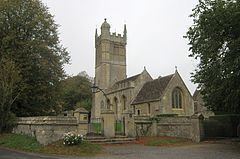OS grid reference ST812590 Sovereign state United Kingdom Dialling code 01225 UK parliament constituency Chippenham | Unitary authority Postcode district BA15 Post town Bradford on Avon Population 1,120 (in 2011) | |
 | ||
Westwood is a large village and a civil parish in west Wiltshire, England. The village is about 1.4 miles (2.3 km) southwest of the town of Bradford on Avon.
Contents
- Map of Westwood Bradford on Avon UK
- Location
- History
- Local government
- Church and chapels
- Notable buildings
- References
Map of Westwood, Bradford-on-Avon, UK
Upper Westwood, on a ridge crest to the north, was a distinct settlement from Lower Westwood but 20th-century housing filled the gap. The parish includes most of the village of Avoncliff, namely the portion south of the Avon, and the hamlet of Lye Green.
Location
The Avon forms most of the northern boundary of the parish; Avoncliff railway station is just over the boundary. The Kennet and Avon canal crosses the parish to the north, as far as the Avoncliff Aqueduct. To the northeast lies Bradford on Avon parish, and to the west is the county boundary with Somerset which follows the valley of the River Frome.
Neighbouring villages are Winsley and Turleigh to the north, and Freshford to the west.
History
Westwood's recorded history begins in 983 AD, when King Ethelred's charters granted various pieces of land to his servant Aelfnoth, and four years later to his huntsman Leofwine. In Norman times, Westwood was one of the estates assigned for the support of the monks at Winchester Priory. The residents of the manor continued to be tenants of the Priory until it was dissolved by Henry VIII. The medieval population of Westwood, as recorded in Domesday Book of 1086, consisted of just 13 households, growing to 45 recorded taxpayers in the late 14th century. The earliest part of the present parish church of St Mary dates from the 13th century or even earlier, though its most impressive features – the Perpendicular Gothic nave, chapel and tower – were added in the late 15th century.
The earliest records of a substantial quarrying industry at Westwood date from 1649. By the mid-19th century, the quality of Westwood stone had earned a good reputation, and over the next half-century, output increased at a great rate. Westwood stone went to build many houses in Bath, as well as Holy Trinity church in Trowbridge (1838). A narrow-gauge railway was constructed to transport the huge blocks of rough cut stone from the quarry to the cutting-yard at Avoncliff railway station. Nowadays, all that remains from the centuries of intensive quarrying is the labyrinth of tunnels, eight feet high and twelve feet wide. They have been put to a number of imaginative uses, especially after they were taken over by the Ministry of Supply in 1939. For example, the eastern part of the quarry tunnels had since 1928 been used for growing mushrooms, as the relatively stable ambient temperatures and the high humidity of the underground were found perfectly suitable. From 1941, about six hundred workers manufactured gun-control equipment at an underground factory which had been located in the tunnels to defend against Luftwaffe raids. Additionally, by the end of 1942 the Westwood tunnels had "probably housed the greatest and most valuable collection of cultural and artistic artifacts assembled in one location anywhere in the world", including exhibits from the British Museum, pictures from the National Portrait Gallery, tapestries from the Victoria and Albert Museum, the Elgin Marbles, and the Wright brothers' aeroplane. An air conditioning plant had to be installed to control the humidity underground.
Local government
The civil parish elects a parish council. It is in the area of Wiltshire Council unitary authority, which is responsible for all significant local government functions.
Until the 19th century Westwood was a chapelry of Bradford on Avon parish.
Church and chapels
The Anglican Church of St Mary the Virgin is Grade I listed.
A Wesleyan Methodist chapel was opened in Upper Westwood in 1862 and closed circa 1960.
A Baptist chapel was opened at Lower Westwood in 1865 and extended with a schoolroom, with capacity for 200 children, in 1885. At first a Sunday school, the room later became the infant school for the village, continuing until 1976 when a new school was built on a different site.
Notable buildings
Westwood Manor, in Lower Westwood next to the church, is a Grade I listed 15th-century manor house operated by the National Trust.
Greenhill House in Upper Westwood is from the 18th century and is Grade II* listed.
Iford Manor, in the Frome valley, is a Grade II* listed manor house from the 15th or 16th century; its gardens by Harold Peto, who lived there from 1899, are Grade I listed. The gardens are the setting for an annual music festival, the Iford Arts Festival.
